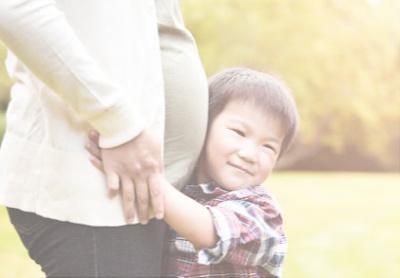Congratulations, mommy-to-be! You’ve made it to the second trimester. So many changes are taking place right now — both physically and emotionally — while your baby grows and develops inside of you.
You may have some questions about what is going to happen over the next several weeks. But don’t worry. The baby experts at Mustela are here to show you what to expect during your second trimester and how to prepare.
Second Trimester Basics
The second trimester includes weeks 14 to 27, meaning your fourth, fifth, and sixth months of pregnancy.
Hopefully, at this stage, you’re feeling somewhat like your old self. What a relief! This trimester of your pregnancy is known as the honeymoon stage because most women report feeling great. (But don’t fret if that’s not you. Every pregnancy is different from one woman to the next.)
Maybe your morning sickness has subsided and you can actually eat...and enjoy eating! Your energy will be up and you won’t be too uncomfortable at this stage in your pregnancy.
Take advantage of how great you’re feeling and start preparing for your little one to arrive. Get the nursery and other things in order now so that you can relax toward the end of your pregnancy.
Second Trimester: What To Expect

Your Body
As you’ve already experienced, your body is going through some major changes. By now, those closest to you have noticed your growing belly.
Round Ligament Pain
Along with your growing belly come abdominal aches during this trimester. Your uterus is expanding, which stretches the surrounding ligaments. This is known as round ligament pain.
Invest in a maternity band if this pain interrupts your daily routine.
Breathlessness
Your lungs can become crowded by your uterus with all the growth and development occurring. As a result, it is often much more difficult for air to flow in and out. Even the most mundane tasks, such as going to the bathroom and walking, may make you feel out of breath.
This is completely normal. However, if your shortness of breath becomes severe, reach out to your doctor right away.
Congestion
Many pregnant women find themselves snoring for the first time during their second trimester. Why is that?
A huge contributing factor is that as your hormone levels increase, your body will produce more blood. This blood flows everywhere, including your mucous membranes.
This increase in blood flow can contribute not only to snoring, but also to general stuffiness, swelling, and nosebleeds.
If congestion is something you’re struggling with, here are few safe ways to find some relief:
- Use a saline rinse or saline drops to help relieve some of the irritating congestion
- Use a humidifier at night to add moisture to the air and prevent dryness
- Continue drinking plenty of fluids
If you’re experiencing nosebleeds, remember to keep your head up straight while applying pressure to your nostrils. This can help to stop the bleeding quickly.
While nosebleeds can be common, if they start happening too often, you might want to have a talk with your doctor to ensure that there aren’t any serious underlying problems.
Weight Gain

Your little one is growing quite a bit during the second trimester, so expect to put on weight more rapidly. Find a store that carries maternity clothing, as you’ll want to stay comfortable while your belly continues to grow.
In addition, you’ll notice your breasts continuing to get larger. They are probably not as tender as they were in the first trimester, but now your milk glands are growing to prepare your body for breastfeeding.
At this stage of your pregnancy, you might need to start buying larger-sized bras that will help to accommodate your growing breasts. But what size should you choose?
It’s really difficult to tell what size bra you need. Some women only go up one size, while others go up several cups. To help guide you, take into consideration your genes — do the women in your family tend to have small, medium, or larger breasts during and post-pregnancy?
In addition to a change in the size of your chest, your breasts also start producing colostrum in your second trimester. This is the very first form of breast milk.
Other changes in your body during this time include:
- Constipation
- Heartburn
- Occasional headaches
- Nasal congestion and possible nosebleeds
- Increased appetite
- Back pain
- Varicose veins
- Hemorrhoids
- More energy
- Leg cramps
- Itchy abdomen
- Increased libido
Swelling Of Ankles And Feet
If you’ve noticed that your ankles and feet are not the size they used to be, you’re not alone! About three in four pregnant women start experiencing mild swelling in their feet from around 22 weeks of gestation. This swelling will often last until you deliver the baby.
To help reduce swelling, you can:
- Try to keep your feet raised when seated
- Continue being active
- Avoid standing or sitting for long periods in the same position
While a bit of swelling and puffiness is perfectly normal, there are times when it can be a cause for concern.
If you’re experiencing excessive swelling and puffiness in your hands or face that lasts longer than a day at a time, this might be a sign of other underlying issues, like preeclampsia.
If you have any suspicions, talk to your doctor, who will advise about the best way forward.
Braxton Hicks Contractions
You can think of Braxton Hicks contractions as your body’s way of preparing for the big day. They commonly start in the second trimester, at 20 weeks into your pregnancy.
What do they feel like?
When you’re experiencing Braxton Hicks, you’ll feel an uncomfortable tightening from the top of your uterine muscles and all the way down. These contractions will become more intense and frequent the closer you get to your estimated due date.
When this happens, try to relax by drinking some water or tea, taking a warm bath, or just changing your position.
Braxton Hicks contractions are fairly common, but some women report not noticing them at all, so don’t be alarmed if you’re not feeling any odd contractions.
As long as you continue going for your regular check-ups and your physician is happy with your progress, there’s nothing to worry about!
Your Emotions

During your first trimester, your hormones had three months to adjust. You may actually be able to better tame your emotions during the second trimester, but you will likely still face some emotional struggles.
Baby Body Blues
Some women find themselves worrying about their changing body and the possible long-term effects. But stay calm, you can combat these emotions with a little self-care. Buy a cute outfit, treat yourself at the spa, or go out with a few encouraging friends to lift your mood.
Baby Blues
You’ve heard of postpartum depression, but what about prepartum depression? Some women experience extreme negative emotions prior to giving birth, which can be a precursor to postpartum depression. Now is the time to discuss any concerns with your doctor.
Additional emotional changes during this time include:
- Fewer mood swings
- Excitement
- Frustration at being in the “in-between” stage (clothing-wise)
- Forgetfulness
- Trouble concentrating
- Occasional weeping and irritability
- Some anxiety about the future
While all of these emotions (both good and bad) are possible, the majority of women find that this stage of pregnancy is when they feel the best, physically and mentally. It’s an exciting time in your life, so embrace your leveled-out moods!
Your Baby

From the time you’re eight weeks into your pregnancy, your baby’s heartbeat can be detected. Most likely you heard your little one’s heartbeat toward the end of your first trimester.
Between 16 and 20 weeks, your baby is so active that you’ll actually be able to feel them move around! However, it’s completely normal if you haven’t felt your little one move yet, especially if this is your first pregnancy.
Month Four
Your baby’s reproductive organs and genitalia are fully developed. Finding out if you’re having a boy or girl is right around the corner — if you decide to find out. Here are some other developmental milestones happening with your little one:
- Well-defined fingers and toes
- Beginning function of the nervous system
- Sucking and swallowing movements
- Yawning
- Stretching
- Making faces
- Muscles getting stronger
- Approximately six inches long
- Weighs about four ounces
Month Five
- Hair growth
- Body covered by lanugo (soft, fine hairs to protect your baby)
- Skin covered with vernix caseosa (whitish coating to protect your baby’s skin from long exposure to amniotic fluid)
- Around 10 inches long
- Weighs anywhere from eight ounces to one pound
Month Six
- Skin appears wrinkled
- Veins are visible through translucent skin
- Fingerprints and toe prints are visible
- Eyes begin to open
- Responding to sounds
- Hiccups are common
- Around 12 inches long
- Weighs about two pounds
Second Trimester: How To Prepare
Exercise

Continue exercising during your second trimester (with the OK from your doctor) to help your body gear up for delivery day. Below are a few exercises to implement throughout the second trimester.
Kegels
To do this exercise, contract your muscles as though you’re trying to stop the flow of urine midstream. Hold and repeat. This exercise will help with pushing during labor.
Prenatal Yoga
Find a class that’s tailored for pregnant women. Prenatal yoga will help you relax and take your mind off of any worries you may have.
Maintain A Healthy Diet
Your baby’s growth is off the charts! Continue to keep up the good work by maintaining a healthy diet full of fruits, vegetables, and protein. Try to avoid sugary and fatty foods. Remember to continue taking your prenatal vitamins.
Some superfoods to include in your diet during pregnancy are:
- Greek yogurt
- Chickpeas
- Peanuts
- Sweet potatoes
- Salmon
- Eggs
- Broccoli (or other dark greens)
- Lean meat (such as beef, pork, and chicken)
- Berries
- Whole-grain foods
- Avocados
- Dried fruit
Prevent Pregnancy Stretch Marks

If you haven’t started implementing a stretch marks prevention regimen into your daily routine, the second semester is definitely the time to do it.
Mustela’s Stretch Marks Cream and Stretch Marks Oil are great options to help prevent and reduce the appearance of stretch marks. You can use it both before delivery and after.
Embrace Maternity Clothes
Your belly has taken on full baby shape. This is exciting! Embrace this time. It’s a good excuse to go shopping, as you’ll want to find clothes that accentuate your growing belly.
Travel Now
The first trimester may have kept you home with nausea and fatigue. And you may face travel restrictions in the third trimester, so now is the perfect time to travel!
You and your significant other can get away, just the two of you, before your little one arrives — better known as a babymoon. And if you are planning a family vacation, you’ll actually have the energy to plan and prepare for some time away with your loved ones.
Other Things To Consider During The Second Trimester

1) Glucose Screening
The American College Of Obstetricians and Gynecologists (ACOG) recommends that pregnant women get a glucose screening between week 24 and week 28 of pregnancy. This screening is important because one in ten pregnant women are diagnosed with gestational diabetes.
Don’t be too alarmed if your tests detect that you have extra glucose in your urine sample, as this is not always an indicator of gestational diabetes.
Your physician may require you to do further testing, and you may need to also change your diet to help lower your blood sugar levels.
2) Your Level 2 Ultrasound
Your level two ultrasound is an important check-up, and it is advised that you have it between 18 to 22 weeks of your pregnancy. At this stage, your baby is big enough for your doctor to gather detailed information about their development.
This is the scan where the physician will measure how big your baby is (so far), determine the amniotic fluid, and check on all their developing organs.
That’s why it’s commonly known as the anatomy scan. And if you’re having multiples, each baby will receive their own scan!
3) Where You Want To Give Birth
If you haven’t made a decision about where you want to give birth yet, now’s the time to really sit and think about your options. You are only a few weeks away from the big day, mama!
Plus, if you can make the decision during the second trimester, you won’t spend your last trimester stressed or worried about where you’re giving birth.
Take some time out and ask yourself these questions:
- Would you like to give birth in a hospital?
- Is a birthing center a better choice for your family?
- Would you be more comfortable giving birth in your own home?
If you’re a little stuck, scheduling a tour at a birthing center or hospital may help you weigh your options and make the right decision for you and your unborn baby.
If you are thinking of giving birth at home, you’ll need to discuss the idea with your medical provider. After assessing all your medical tests and having a look at your overall health and family history, they will be able to advise whether this is the safest option for you and your baby.
4) Childcare Options
Childcare is often one of the last things pregnant women sort out. And we get it! You’re probably preoccupied with so many to-dos and you think that you’ll get to it soon.
But the reality is, nine months fly by quickly! Before you know it, your due date will be right around the corner.
To give you peace of mind, start looking into your childcare options as soon as possible.
Are you a working mom? Do you have multiple children? Will your maternity leave be short? Take a moment to look at your unique circumstances and consider what the best option for your family will be.
Whether you choose a relative, nanny, babysitter, or local daycare, it’s never too early to start gathering the information you need so you can make an informed decision.
5) Your Baby Shower
While your close friends or relatives will likely be the ones planning your shower, there’s no harm in sharing with them any requests you may have.
Is there a specific theme you would love? Are you craving certain foods? If the requests are reasonable, your loved ones will be more than willing to make them a reality.
Speaking of baby showers, now is a good time to create a baby registry to ensure that you give your guests and loved ones direction about the items that you need for your new baby.
6) Take Plenty Of Photos

Every pregnancy is unique and should be celebrated! One of the easiest ways to keep track of all the incredible changes your body is going through is by taking lots of photos.
Whether you decide to do weekly or bi-weekly shots, this is the quickest and most affordable way to look back on your incredible journey.
While you’re at it, you might also want to schedule your baby bump photoshoot. Most mothers decide to do their shoot during the third trimester when their belly is more visible. But you can definitely start researching photographers and booking for the big day right now.
Since pregnancy shoots have become increasingly popular over the past few years, you want to book ones as soon as you can to ensure that you get the photographer you want and avoid disappointment.
Thriving During Your Second Trimester

Your little one is reaching several growth milestones during these three months. Maintain a healthy diet and exercise regularly to continue promoting your baby’s growth. And remember to take care of your skin with a stretch marks cream or oil.
Finally, enjoy this stage of your pregnancy by embracing your growing belly and by traveling. Relish time with your loved ones by getting away for a few days while you’re feeling great.
Before you know it, you’ll be holding your new bundle of joy in your arms!












